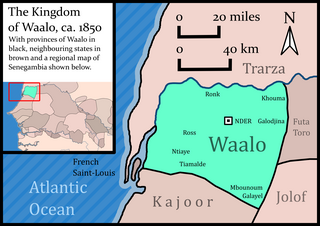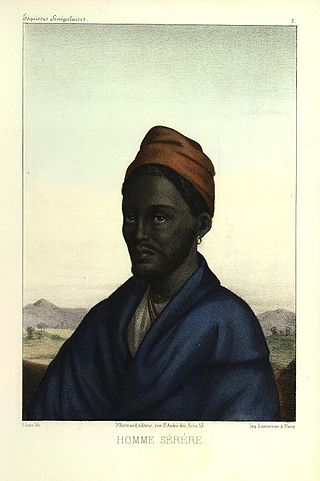The Principality of Bethio was a small monarchy located for centuries along the lower Senegal River valley, on the border between modern Mauritania and Senegal, in the northeast of Biffeche. In the 18th century it was also called the "Royaume d'Oral." Its capital was at Poum, then moved to N'Dombo, and finally moved to Ross, Senegal in the 19th century. The original, fertile farmlands of Bethio are in a region just east of the Djoudj National Bird Sanctuary.

Waalo was a kingdom on the lower Senegal River in West Africa, in what is now Senegal and Mauritania. It included parts of the valley proper and areas north and south, extending to the Atlantic Ocean. To the north were Moorish emirates; to the south was the kingdom of Cayor; to the east was Jolof.

The Serer-Ndut or Ndut also spelt are an ethnic group in Senegal numbering 38600. They are part of the Serer people who collectively make up the third largest ethnic group in Senegal. The Serer-Ndut live mostly in western Senegal in the district of Mont-Roland, northwest of the city of Thiès.

The Kingdom of Sine was a post-classical Serer kingdom along the north bank of the Saloum River delta in modern Senegal. The inhabitants are called Siin-Siin or Sine-Sine.
This is a list of states headed by the Serer Lamanes. The Lamanes have a historical, economic and religious significance in Serer countries. The following pre-colonial kingdoms and new states (post-independence) were for a long time dominated by the Serer Lamanic class :
Father Henry Gravrand was a French Catholic missionary to Africa and an anthropologist who has written extensively on Serer religion and culture. He was one of the leading pioneers of interfaith dialog and believed that African religion was the "'first covenant between God and man". His works about the Serer people are cited by other historians and scholars writing on Serer history, religion and culture, for instance Martin A. Klein, Charles Becker, Alioune Sarr, Marguerite Dupire, Issa Laye Thiaw, etc. Papa Massène Sene argues that his approach lacks scientific rigor and include fundamental linguistic and historical errors. Alioune Sarr noted that Gravrand reported an oral tradition describing what he called the "Battle of Troubang", a dynastic war between the two maternal royal houses of Ñaanco and the Guelowar, an off-shot and relatives of the Ñaanco maternal dynasty of Kaabu, in modern-day Guinea Bissau. According to Charles Becker, Gravrand is confusing a description of the 1867 Battle of Kansala.

Teigne was a Serer title for the monarchs of the pre-colonial Kingdom of Baol, now part of present-day Senegal. The Kingdoms of Baol and Cayor became intricately linked especially post 1549 when the Faal family came to into prominence, and it was the same family that eventually ruled both Kingdoms with the exception of few interruptions, notably Lat Joor Ngoneh Latir Jobe who was of a different patrilineage.
Tukar a large village in Senegal. Attached to the rural community of Ngayokhem, it is located in the area of the pre-colonial Kingdom of Sine, west of Senegal. The population is overrun by the Serers. As of 2006 to 2007, the population was estimated at 3000. Ndokh, which was a colony of Tukar, is now a separate village.

The Point of Sangomar is a sand spit located on the Atlantic Ocean at the mouth of the Saloum Delta, which marks the end of the Petite Côte west of Senegal.
Marguerite Dupire was a French ethnologist who specialised on African people, and worked extensively on the Fulani of Niger, Cameroon, Guinea, Senegal, and then after a mission in Ivory Coast, on the Serer people of Sine since 1965.
Kopé Tiatie Cac is the Supreme Creator in the Serer religion. Kopé Tiatie Cac is the name used by the Ndut people to refer to the Supreme being. Among the Ndut and followers of Serer religion, Kopé Tiatie Cac is associated with death and plague (pisti).
The Serer creation myth is the traditional creation myth of the Serer people of Senegal, the Gambia and Mauritania. Many Serers who adhere to the tenets of the Serer religion believe these narratives to be sacred. Some aspects of Serer religious and Ndut traditions are included in the narratives contained herein but are not limited to them.
Kokh Kox is the creator god of the Noon people. The Noon are members of the Serer ethnic group of Senegal, the Gambia and Mauritania. Kokh Kox is one of the main deities in Serer religion. The Noon people refer to the supreme being as Kokh Kox rather than Roog, the name the majority of Serers refer to the supreme being in the Serer-Sine language. The name Kokh Kox derives from the deity Koox, the name the Saafi people regularly use to refer to the divine.
The Njuup tradition is a Serer style of music rooted in the Ndut initiation rite, which is a rite of passage that young Serers must go through once in their lifetime as commanded in the Serer religion.

Lingeer Fatim Beye Joos Fadiou was a 14th-century Serer princess and queen (Lingeer) from the Kingdom of Sine. She is the matriarch and early ancestor of the Joos Maternal Dynasty of Waalo. She is usually regarded by some sources as the founder of the Joos Maternal Dynasty. The pre-colonial Kingdoms of Sine and Waalo now lies within present-day Senegal. Her surname is Beye (English-Gambia) or Bèye (French-Senegal). Joos Fadiou is her maternal clan. In Serer, "Fa-tim" means "the maternal clan of..."

The Joos Maternal Dynasty was a Serer maternal dynasty which originated from the Serer pre-colonial Kingdom of Sine in the 14th century and spread to the Wolof Kingdom of Waalo. The matriarch or founder of this maternal dynasty was Lingeer Fatim Beye, a princess and queen originally from the Kingdom of Sine. In Waalo, it was founded by the princess Lingeer Ndoye Demba of Sine. Lingeer Ndoye Demba was the maternal granddaughter of Lingeer Fatim Beye. They both came from the Serer ethnic group. The pre-colonial Kingdoms of Sine and Waalo now forming a part of modern-day Senegal maintained good relations with other pre-colonial kingdoms.
Serer maternal clans or Serer matriclans are the maternal clans of the Serer people of Senegal, the Gambia and Mauritania. The Serer are both patrilineal and matrilineal. Inheritance depends on the nature of the asset being inherited – i.e. whether it is a maternal asset which requires maternal inheritance or paternal asset requiring paternal inheritance (kucarla). The Serer woman play a vital role in royal and religious affairs. In pre-colonial times until the abolition of their monarchies, a Serer king would be required to crown his mother, maternal aunt or sister as Lingeer (queen) after his own coronation. This re-affirms the maternal lineage to which they both belong (Tim). The Lingeer was very powerful and had her own army and palace. She was the queen of all women and presided over female cases. From a religious perspective, the Serer woman plays a vital role in Serer religion. As members of the Serer priestly class, they are among the guardians of Serer religion, sciences, ethics and culture. There are several Serer matriclans; not all of them are listed here. Alliance between matriclans in order to achieve a common goal was, and still is very common. The same clan can be called a different name depending on which part of Serer country one finds oneself in. Some of these matriclans form part of Serer mythology and dynastic history. The mythology afforded to some of these clans draws parallels with the Serer creation narrative, which posits that: the first human to be created was a female. Many Serers who adhere to the tenets of Serer religion believe these narratives to contain profound truths which are historic or pre-historic in nature.

Boukar Djillakh Faye was a 14th-century Serer wrestler (njom) from the post-classical Kingdom of Sine which lies within present-day Senegal.
Laurent Durand was an 18th-century French publisher active in the Age of Enlightenment. His shop was established rue Saint-Jacques under the sign Saint Landry & du griffon.

Maad is the title given to a male monarch by the Serer people of Senegal, Gambia and Mauritania. In Serer royal history, the Maad possessed supreme power throughout Serer country. The Maad was chosen from the royal lineage and crowned by the great Jaraaf who was equivalent to a prime minister. After his coronation, he would crown a member of his maternal family, usually his mother, sister, maternal aunt, or wife as Lingeer (Queen). The Serer titles Maad a Sinig and Maad Saloum take their names from the radical Serer title Maad, and identifies which part of Serer country they rule.








